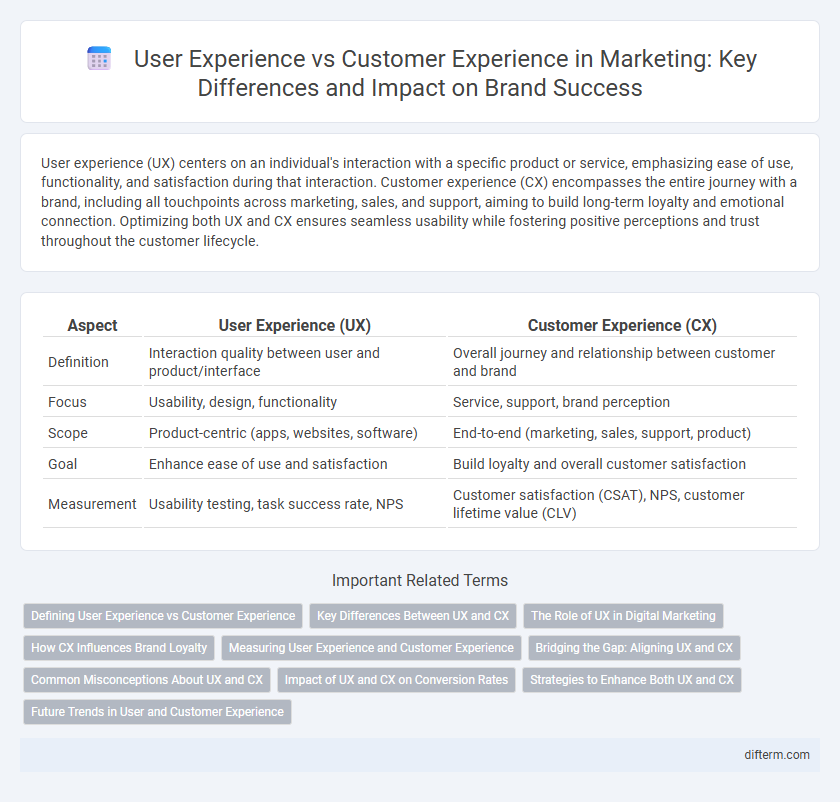User experience (UX) centers on an individual's interaction with a specific product or service, emphasizing ease of use, functionality, and satisfaction during that interaction. Customer experience (CX) encompasses the entire journey with a brand, including all touchpoints across marketing, sales, and support, aiming to build long-term loyalty and emotional connection. Optimizing both UX and CX ensures seamless usability while fostering positive perceptions and trust throughout the customer lifecycle.
Table of Comparison
| Aspect | User Experience (UX) | Customer Experience (CX) |
|---|---|---|
| Definition | Interaction quality between user and product/interface | Overall journey and relationship between customer and brand |
| Focus | Usability, design, functionality | Service, support, brand perception |
| Scope | Product-centric (apps, websites, software) | End-to-end (marketing, sales, support, product) |
| Goal | Enhance ease of use and satisfaction | Build loyalty and overall customer satisfaction |
| Measurement | Usability testing, task success rate, NPS | Customer satisfaction (CSAT), NPS, customer lifetime value (CLV) |
Defining User Experience vs Customer Experience
User experience (UX) focuses on a person's interaction with a product, system, or service, emphasizing usability, accessibility, and satisfaction during specific touchpoints. Customer experience (CX) encompasses every interaction a customer has with a brand across multiple channels and over time, including marketing, sales, and post-purchase support. Defining UX and CX requires understanding that UX is a subset of CX, centered on product interaction, whereas CX covers the holistic relationship between the customer and the company.
Key Differences Between UX and CX
User Experience (UX) focuses on the interaction between a user and a specific product or service, emphasizing usability, design, and functionality to enhance satisfaction. Customer Experience (CX) encompasses the entire journey a customer has with a brand, including all touchpoints such as marketing, sales, and support, aiming to build long-term loyalty and emotional connection. Key differences lie in UX's product-centric scope versus CX's broader, relationship-driven perspective across multiple channels and interactions.
The Role of UX in Digital Marketing
User experience (UX) plays a critical role in digital marketing by enhancing website usability, boosting engagement, and increasing conversion rates. Optimizing UX through intuitive design, fast loading times, and personalized interactions directly influences customer satisfaction and brand loyalty. Effective UX strategies align with overall customer experience (CX) goals to create seamless digital journeys that drive business growth.
How CX Influences Brand Loyalty
Customer experience (CX) shapes brand loyalty by creating emotional connections through consistent, personalized interactions across all touchpoints, leading to increased customer retention and advocacy. Positive CX enhances perceived value, driving repeated purchases and reducing churn rates significantly. Brands investing in seamless omnichannel experiences see up to 25% higher customer lifetime value, directly boosting long-term revenue growth.
Measuring User Experience and Customer Experience
Measuring user experience (UX) relies on usability testing, task success rates, and time-on-task metrics to evaluate how effectively users interact with a product or service. Customer experience (CX) measurement incorporates customer satisfaction (CSAT), Net Promoter Score (NPS), and customer effort score (CES) to assess overall brand perception and loyalty. Integrating quantitative data from UX with qualitative insights from CX provides a comprehensive view for enhancing engagement and retention strategies.
Bridging the Gap: Aligning UX and CX
Bridging the gap between User Experience (UX) and Customer Experience (CX) enhances brand loyalty by creating consistent interactions across digital and physical touchpoints. Aligning UX design with CX strategies ensures seamless navigation, personalized engagement, and responsive support, which collectively drive higher customer satisfaction and retention rates. Integrating data analytics from both UX and CX channels enables businesses to identify pain points and optimize the end-to-end journey for maximum impact.
Common Misconceptions About UX and CX
Common misconceptions about user experience (UX) and customer experience (CX) often confuse UX as solely related to digital interfaces and CX as limited to post-purchase interactions. UX encompasses the entire interaction users have with a product or service, including usability, accessibility, and emotional impact, while CX covers all touchpoints throughout the customer journey, from discovery to loyalty. Misunderstanding these distinctions can lead to ineffective marketing strategies and missed opportunities in enhancing brand loyalty and satisfaction.
Impact of UX and CX on Conversion Rates
User experience (UX) directly influences conversion rates by ensuring intuitive navigation, fast load times, and visually appealing interfaces that reduce friction during decision-making. Customer experience (CX) encompasses broader interactions beyond the product, including support, personalization, and post-purchase engagement, which foster loyalty and repeat conversions. Optimizing both UX and CX creates a seamless journey that significantly boosts overall conversion rates and customer lifetime value.
Strategies to Enhance Both UX and CX
Implementing personalized interactions through data analytics significantly improves both user experience (UX) and customer experience (CX) by delivering relevant content and offers. Integrating omnichannel support ensures seamless transitions across devices and platforms, enhancing satisfaction and loyalty. Continuous feedback loops using surveys and behavioral data enable iterative enhancements that align product design with customer expectations.
Future Trends in User and Customer Experience
Future trends in user experience (UX) and customer experience (CX) emphasize personalized interactions powered by AI and machine learning, driving seamless omnichannel engagement. Immersive technologies like augmented reality (AR) and virtual reality (VR) are enhancing both UX and CX by creating interactive and intuitive environments. Predictive analytics and real-time data integration enable brands to anticipate customer needs, elevating satisfaction and loyalty across digital platforms.
User experience vs Customer experience Infographic

 difterm.com
difterm.com